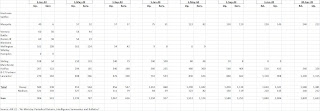Let’s have a look at the Bomber Command strength from AIR 22 - 'Air Ministry: Periodical Returns, Intelligence Summaries and Bulletins':
Est.: Establishment strength in operational units.
Op.: Aircraft in operational units.
Serv.: Serviceable aircraft in operational units.
Crews.: Aircraft in operational units with crews.
Some comments:
For the first half of the war the StrategicTM RAF has no strategic (4-engine) bombers.
Bomber Command strength goes up in the period 1939-42 but then there is a slight decrease in numbers during ’42 as the new 4-engine bombers are introduced and the old tactical bombers are withdrawn from service. From ’43 numbers go up again.
The rise in numbers is not rapid. This is due to two main factors:
1. The inability of British industry to provide for a massive surge in 4-engine bomber production.
2. The heavy losses inflicted on BC by the Luftwaffe’s Night-fighters (Nachtjagd) and the Flak forces.
Compared to the Luftwaffe’s Bomber force the RAF’s BC is numerically inferior in the period 1939-43.
Regarding the types of aircraft, it is interesting to note that many different types are used concurrently. For example in May ’41 there are: Blenheim, Wellington, Whitley, Hampden, Stirling, Manchester, Halifax.
Standardization wins out in the end. In May ’44 there are only four types in use: the Mosquito, the Lancaster, the Stirling and the Halifax.
The effects of Lend Lease are minimal when it comes to BC aircraft. Only a few Boston bombers are used in the period 1942-43 and the B-17 Fortress for a short time in 1941-42.
Further reading: An excellent study of the costs of BC for the British economy can be found here.


No comments:
Post a Comment